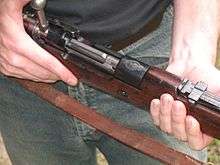Argentine Mauser Model 1909
The Argentine Mauser Model 1909 were Gewehr 98 pattern bolt-action battle rifles designed for the Argentine Army. They were produced both in Germany and in Argentina.
| Mauser Modelo Argentino 1909 | |
|---|---|
| Type | Bolt-action rifle |
| Place of origin | Germany |
| Service history | |
| In service | 1905-1960s |
| Used by | Argentina Paraguay |
| Wars | Chaco War |
| Production history | |
| Designed | 1909 |
| Manufacturer | DWM Fabrica Militar de Armas Portatiles |
| Produced | 1909-1959 |
| No. built | ~285,000 |
| Specifications | |
| Mass | 4.17 kilograms (9.2 lb) |
| Length | 124 centimetres (49 in) |
| Barrel length | 74 centimetres (29 in) |
| Cartridge | 7.65×53mm Mauser |
| Action | Bolt-action |
| Muzzle velocity | 839.6 metres per second (2,755 ft/s) |
| Feed system | 5-round stripper clip, internal magazine |
| Sights | Iron sights adjustable to 2,000 metres (2,200 yd) |
Design

The Mauser 1909 was a slightly modified copy of the Gewehr 98. Among other modifications, the Lange Visier sight was replaced by a tangent leaf sight. The M1909 was also able to use the bayonet of the Mauser 1891 it replaced.[1] The main producer in Germany was Deutsche Waffen und Munitionsfabriken that delivered 200,000 rifles[2] while around 85,000 rifles[1] were manufactured by the Fabrica Militar de Armas Portatiles, governmental plants in Rosario and Santa Fe. The Model 1909s were replaced by FN FALs[3] without having seen combat[4].
Some Argentine Mauser 1909 rifles and carbines without crests were sold to Paraguay during the Chaco War.[1]
Variants
- Mauser 1909 sniper rifle: version with a German-made scope and a bent-down bolt handle.[4]
- Mauser 1909 cavalry carbine: shortened variant, with a straight grip stock and a forecap that covers all the barrel.[5] The bayonet can be attached under this forecap.[6]
- Mauser 1909 Mountain Carbine or Engineers Carbine: probably cut-down rifles[6]
Peruvian Mauser 1909

Peru received between 1910 and 1914 thousands of Mauser Model 1909 rifles, chambered in 7.65 Mauser. They were closer copies of the Gewehr 98, including the Lange Visier sight.[7] Aside from the caliber, the only differences were the larger receiver ring, the 5 mm (0.20 in) shorter breech, the slightly modified strip guide to use older Model 1891 strips, the longer hammer, the aspheric shape of the bolt handle and the Peruvian markings.[8] While these rifles were able to fire the old bullets with round nose, they were later adapted to spitzer bullets.[9] These weapons were used during the Leticia Incident and the Ecuadorian–Peruvian War.[10] After 1945, the Mauser 1909s were replaced by American weapons and were sold in the civilian market in the 1960s, a few being kept as ceremonial rifles.[11]
References
- Ball 2011, p. 12.
- Webster 2003, p. .
- Ball 2011, p. 9.
- Ball 2011, p. 14.
- Ball 2011, p. 15.
- Ball 2011, p. 18.
- Ball 2011, pp. 289-290.
- Guillou 2006, pp. 23-24.
- Guillou 2006, pp. 24-25.
- Jowett, Philip (28 Jun 2018). Latin American Wars 1900–1941: "Banana Wars," Border Wars & Revolutions. Men-at-Arms 519. Osprey Publishing. pp. 29, 46. ISBN 9781472826282.
- Guillou 2006, p. 25.
- Ball, Robert W. D. (2011). Mauser Military Rifles of the World. Iola: Gun Digest Books. ISBN 9781440228926.CS1 maint: ref=harv (link)
- Guillou, Luc (December 2006). Le fusil Mauser peruvien modèle 1909. Gazette des Armes (in French). pp. 22–25.CS1 maint: ref=harv (link)
- Webster, Colin (2003). Argentine Mauser Rifles 1871-1959. Schiffer Publishing. ISBN 978-0764318689.CS1 maint: ref=harv (link)